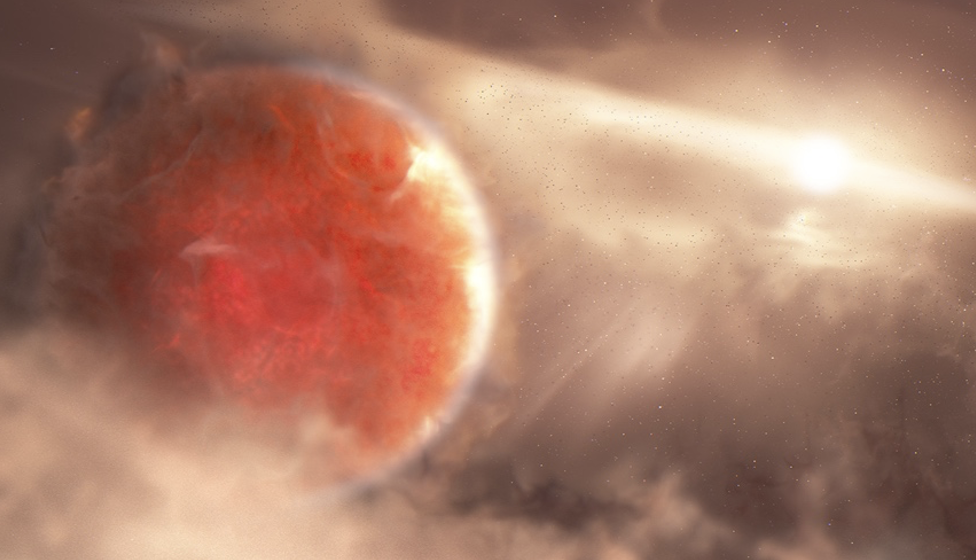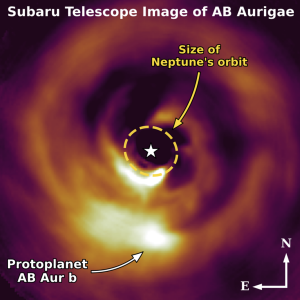
A University of Oklahoma graduate student has played a critical role in a Jupiter-like protoplanet forming through what researchers describe as an "intense and violent process." This discovery provides the first plausible detection of a planet via long-debated theory for how planets like Jupiter form
Kellen Lawson, a doctoral student in the research group led by John Wisniewski, Presidential Professor in the Homer L. Dodge Department of Physics and Astronomy at the Dodge Family College of Arts and Sciences, led analysis of extreme adaptive-optics coronagraphic integral field polarimetry observations of the system. Thayne Currie of the Subaru Telescope and Eureka Scientific was lead researcher on the study and Lawson was the second author. The group was supported by a collaborative grant from NASA’s Exoplanet Research Program, for which Wisniewski is the principal investigator.
The group's results are detailed in their paper “Images of Embedded Jovian Planet Formation at Wide Separations around AB Aurigae,” which is published in the April 4 issue of Nature Astronomy.

The new world under construction is embedded in a protoplanetary disk of dust and gas with distinct spiral structure swirling around a young star that’s estimated to be around 2 million years old. That's about the age of our solar system when planet formation was underway.
All planets are made from material that originated in a circumstellar disk. The dominant theory for planet formation is called "core accretion," a bottom-up approach where planets embedded in the disk grow from small objects – with sizes ranging from dust grains to boulders – colliding and sticking together as they orbit a star. This core then slowly accumulates gas from the disk. In contrast, the disk instability approach is a top-down model whereas a massive disk around a star cools and gravity causes the disk to rapidly break up into one or more planet-mass fragments.
The newly forming planet, called AB Aurigae b, is probably about nine times more massive than Jupiter and orbits its host star at a whopping distance of 8.6 billion miles – over two times farther than Pluto is from our Sun. At that distance, it would take a very long time, if ever, for a Jupiter-sized planet to form by core accretion. This researchers to And it is in a striking contrast to expectations of planet formation by the widely accepted core accretion model.
The new analysis combines data from two Hubble instruments: the Space Telescope Imaging Spectrograph and the Near Infrared Camera and Multi-Object Spectrograph. These data were compared to those from a state-of-the-art planet-imaging instrument called SCExAO on Japan's 8.2-meter Subaru Telescope, located at the summit of Mauna Kea, Hawaii. The wealth of data from space and ground-based telescopes proved critical, because distinguishing between infant planets and complex disk features unrelated to planets is very difficult.
“This was a remarkably comprehensive study of this system, using observations from a huge array of instruments and spanning more than a decade,” said Lawson. “It was extremely exciting for me to be able to develop some new techniques to leverage this data and to help validate this object.”
One way to disentangle a possible planet from disk structure is to observe a system at different wavelengths of light and to then show that the planet’s brightness across wavelengths, or “spectrum,” is distinct from that of the material in the disk. However, the faint light from planets and disks is initially buried beneath the intense light of the parent star, which must be removed before they can be studied. The methods normally used inadvertently toss out varying amounts of light from the disk and any planets as well, making it difficult to compare their brightness. Lawson’s analysis incorporated polarized light images of the system to allow for much more accurate removal of the starlight, in turn allowing the enshrouded planet’s distinct spectrum to be verified.
"Kellen developed a novel analysis technique that really played an important role in confirming the nature of AB Aurigae b," said Wisniewski. "He is the embodiment of excellence in our graduate program, and I've been lucky to have the chance to collaborate with him during his time at OU."
Understanding the early days of the formation of Jupiter-like planets provides astronomers with more context into the history of our own solar system. This discovery paves the way for future studies of the chemical make-up of protoplanetary disks like AB Aurigae b.
The Hubble Space Telescope is a project of international cooperation between the National Aeronautics and Space Administration and the European Space Agency. NASA's Goddard Space Flight Center in Greenbelt, Maryland, manages the telescope. The Space Telescope Science Institute in Baltimore conducts Hubble science operations. STScI is operated for NASA by the Association of Universities for Research in Astronomy, in Washington, D.C.
Top Image: ARTIST’S CONCEPT OF AB AURIGAE B
This is an artist's illustration of a massive, newly forming exoplanet called AB Aurigae b. Researchers used new and archival data from the Hubble Space Telescope and the Subaru Telescope to confirm this protoplanet is forming through an intense and violent process, called disk instability. Disk instability is a top-down approach, much different from the dominant core accretion model. In this scenario, a massive disk around a star cools and gravity causes the disk to rapidly break up into one or more planet-mass fragments. AB Aurigae b is estimated to be about nine times more massive than Jupiter and orbits its host star over two times farther than Pluto is from our Sun. Illustration Credit: NASA, ESA, STScI, Joseph Olmsted (STScI)
Second Image: Image of the star AB Aurigae, taken by the Subaru Telescope, showing the spiral arms in the disk and the newly discovered protoplanet AB Aur b. The bright central star has been masked, and its location is indicated by the star mark (☆). The size of Neptune’s orbit in the Solar System is shown to provide scale. (Credit: T. Currie, K. Lawson/Subaru Telescope)

